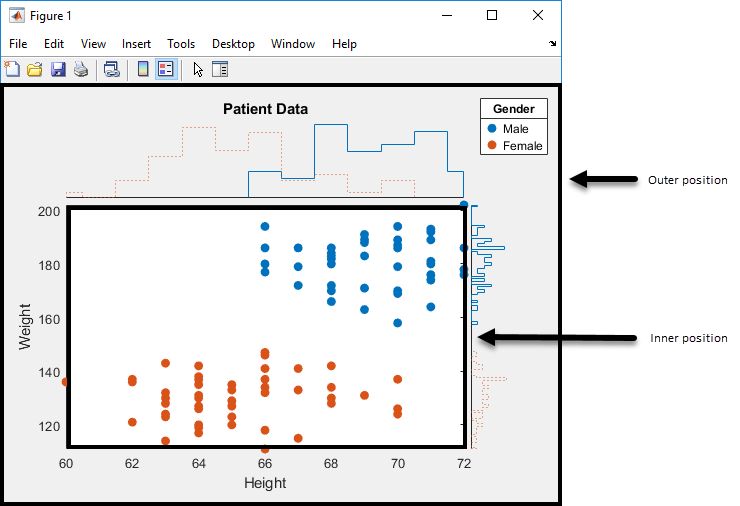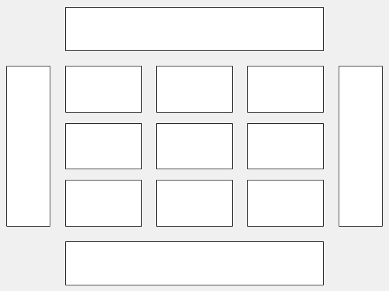ScatterHistogramChart 属性
控制散点直方图的外观和行为
ScatterHistogramChart 属性控制 ScatterHistogramChart 对象的外观和行为。通过更改属性值,您可以修改图显示的特定方面。例如,您可以添加标题:
s = scatterhistogram(rand(10,1),rand(10,1));
s.Title = 'My Title';标签
图标题,指定为字符向量、字符串数组、字符向量元胞数组或分类数组。默认图没有标题。
要创建一个多行标题,请指定字符串数组或字符向量元胞数组。数组中的每个元素对应一行文本。
如果将标题指定为分类数组,MATLAB® 将使用数组中的值,而不是类别。
示例: s = scatterhistogram(__,'Title','My Title Text')
示例: s.Title = 'My Title Text'
示例: s.Title = {'My','Title'}
x 轴的标签,指定为字符向量、字符串数组、字符向量元胞数组或分类数组。使用 '' 表示没有标签。
要创建一个多行标签,请指定字符串数组或字符向量元胞数组。数组中的每个元素对应一行文本。
如果将标签指定为分类数组,MATLAB 将使用数组中的值,而不是类别。
示例: s = scatterhistogram(__,'XLabel','My Label')
示例: s.XLabel = 'My Label'
示例: s.XLabel = {'My','Label'}
y 轴的标签,指定为字符向量、字符串数组、字符向量元胞数组或分类数组。使用 '' 表示没有标签。
要创建一个多行标签,请指定字符串数组或字符向量元胞数组。数组中的每个元素对应一行文本。
如果将标签指定为分类数组,MATLAB 将使用数组中的值,而不是类别。
示例: s = scatterhistogram(__,'YLabel','My Label')
示例: s.YLabel = 'My Label'
示例: s.YLabel = {'My','Label'}
图例标题,指定为字符向量、字符串数组、字符向量元胞数组或分类数组。使用 '' 表示没有标题。
要创建一个多行标题,请指定字符串数组或字符向量元胞数组。数组中的每个元素对应一行文本。
如果将标题指定为分类数组,MATLAB 将使用数组中的值,而不是类别。
示例: s = scatterhistogram(__,'LegendTitle','My Title Text')
示例: s.LegendTitle = 'My Title Text'
示例: s.LegendTitle = {'My','Title'}
直方图
直方图 bin 数量,指定为正整数标量、2×1 正整数向量或 2×n 正整数矩阵,其中 n 为 GroupData 中的组数。
| 指定的值 | 描述 |
|---|---|
| 标量 | 该值是 x 和 y 直方图的 bin 数量。 |
| 2×1 向量 | 第一个值是 x 数据的 bin 数量,第二个值是 y 数据的 bin 数量。 |
| 2×n 矩阵 | (1,j) 值是第 j 个组中 x 数据的直方图的 bin 数量。同样,(2,j) 值是第 j 个组中 y 数据的直方图的 bin 数量。 |
scatterhistogram 使用 histogram 的 'BinMethod','auto' 名称-值对组参量来确定默认 NumBins 和 BinWidths 值。
您不能更改分类数据的 NumBins。
示例: s = scatterhistogram(__,'NumBins',20)
示例: s.NumBins = [10; 15]
直方图 bin 宽度,指定为正标量、2×1 正向量或 2×n 正矩阵,其中 n 是 GroupData 中组的数量。
| 指定的值 | 描述 |
|---|---|
| 标量 | 该值是 x 和 y 直方图的 bin 宽度。 |
| 2×1 向量 | 第一个值是 x 数据的 bin 宽度,第二个值是 y 数据的 bin 宽度。 |
| 2×n 矩阵 | (1,j) 值是第 j 个组中 x 数据的直方图的 bin 宽度。同样,(2,j) 值是第 j 个组中 y 数据的直方图的 bin 宽度。 |
scatterhistogram 使用 histogram 的 'BinMethod','auto' 名称-值对组参量来确定默认 NumBins 和 BinWidths 值。分类数据的 BinWidths 值始终为 0。当 HistogramDisplayStyle 为 "smooth" 时,BinWidths 是核密度估计器 kde 的带宽。
如果设置 BinWidths,则 scatterhistogram 将忽略 NumBins 值。
示例: s = scatterhistogram(__,'BinWidths',0.5)
示例: s.BinWidths = [1.5; 2]
x 数据直方图的方向,指定为 'up' 或 'down'。如果 XHistogramDirection 值为 'up',则 x 数据直方图的条形向上。如果 XHistogramDirection 值为 'down',则 x 数据直方图的条形向下。
示例: s = scatterhistogram(__,'XHistogramDirection','down')
示例: s.XHistogramDirection = 'down'
y 数据直方图的方向,指定为 'right' 或 'left'。如果 YHistogramDirection 值为 'right',则 y 数据直方图的条形向右。如果 YHistogramDirection 值为 'left',则 y 数据直方图的条形向左。
示例: s = scatterhistogram(__,'YHistogramDirection','left')
示例: s.YHistogramDirection = 'left'
直方图显示样式,指定为下列选项之一。
| 显示样式 | 描述 |
|---|---|
'stairs' | 显示阶梯图,该图显示直方图的轮廓而不填充条形。 |
'bar' | 显示直方条形图。 |
'smooth' | 显示通过核密度估计值生成的平滑图。 |
scatterhistogram 使用 'pdf' 归一化类型来生成直方图。有关详细信息,请参阅 histogram 的 'Normalization' 名称-值对组参量。
示例: s = scatterhistogram(__,'HistogramDisplayStyle','smooth')
示例: s.HistogramDisplayStyle = 'bar'
直方图线型,指定为下列形式之一:
指定一种线型的字符向量
指定一个或多个线型的字符串数组或字符向量元胞数组
从这些线型选项中进行选择。
| 线型 | 描述 | 表示的线条 |
|---|---|---|
"-" | 实线 |
|
"--" | 虚线 |
|
":" | 点线 |
|
"-." | 点划线 |
|
"none" | 无线条 | 无线条 |
当组的总数超过指定的线型数量时,scatterhistogram 将循环使用指定的线型。
示例: s = scatterhistogram(__,'LineStyle',':')
示例: s.LineStyle = {':','-','-.'}
直方图线宽,指定为正标量或正向量,以磅为单位。默认情况下,scatterhistogram 为直方图中的每个线条指定 0.5 的线宽。
当组的总数超过指定的线宽数量时,scatterhistogram 将循环使用指定的线宽。
示例: s = scatterhistogram(__,'LineWidth',0.75)
示例: s.LineWidth = [0.5 0.75 0.5]
颜色和字体
组颜色,指定为下列形式之一:
指定颜色名称的字符向量。
指定一个或多个颜色名称的字符串数组或字符向量元胞数组。
范围 [0,1] 内的 RGB 值的三列矩阵。三列分别代表 R 值、G 值和 B 值。
在这些预定义颜色及其等效的 RGB 三元组中进行选择。
| 选项 | 描述 | 对应的 RGB 三元组 |
|---|---|---|
'red' 或 'r' | 红色 | [1 0 0] |
'green' 或 'g' | 绿色 | [0 1 0] |
'blue' 或 'b' | 蓝色 | [0 0 1] |
'yellow' 或 'y' | 黄色 | [1 1 0] |
'magenta' 或 'm' | 品红色 | [1 0 1] |
'cyan' 或 'c' | 青蓝色 | [0 1 1] |
'white' 或 'w' | 白色 | [1 1 1] |
'black' 或 'k' | 黑色 | [0 0 0] |
默认情况下,scatterhistogram 最多分配七种唯一的组颜色。当组的总数超过指定的颜色数量时,scatterhistogram 将循环使用指定的颜色。
示例: s = scatterhistogram(__,'Color',{'blue','green',red'})
示例: s.Color = [0 0 1; 0 0.5 0.5; 0.5 0.5 0.5]
字体名称,指定为系统支持的一种字体名称。标题、轴标签、图例标题和组名称使用相同的字体。默认字体取决于具体操作系统和区域设置。
示例: s = scatterhistogram(__,'FontName','Cambria')
示例: s.FontName = 'Cambria'
字体大小,指定为标量值。FontSize 对于标题、轴标签、图例标题和组名称是相同的。默认字体大小取决于具体操作系统和区域设置。
当您调整绘图元素的大小时,软件会自动更新字体大小。但是,更改 FontSize 属性会禁用这一自动调整大小功能。
示例: s = scatterhistogram(__,'FontSize',12)
示例: s.FontSize = 12
标记
每个散点图组的标记符号,指定为下列形式之一:
指定标记样式的字符向量
指定一个或多个标记样式的字符串数组或字符向量元胞数组
从这些标记选项中进行选择。
| 标记 | 描述 | 生成的标记 |
|---|---|---|
"o" | 圆圈 |
|
"+" | 加号 |
|
"*" | 星号 |
|
"." | 点 |
|
"x" | 叉号 |
|
"_" | 水平线条 |
|
"|" | 垂直线条 |
|
"square" | 方形 |
|
"diamond" | 菱形 |
|
"^" | 上三角 |
|
"v" | 下三角 |
|
">" | 右三角 |
|
"<" | 左三角 |
|
"pentagram" | 五角形 |
|
"hexagram" | 六角形 |
|
"none" | 无标记 | 不适用 |
默认情况下,scatterhistogram 为散点图中的每个组指定标记符号 'o'。当组的总数超过指定的符号数量时,scatterhistogram 将循环使用指定的符号。
示例: s = scatterhistogram(__,'MarkerStyle','x')
示例: s.MarkerStyle = {'x','o'}
每个散点图组的标记大小,指定为非负标量或非负向量,其值以磅为单位。默认情况下,scatterhistogram 将散点图中每个组的标记大小指定为 36。当组的总数超过指定的值数量时,scatterhistogram 将循环使用指定的值。
示例: s = scatterhistogram(__,'MarkerSize',30)
示例: s.MarkerSize = 40
标记面的填充状态,指定为 'on' 或 'off'。如果 MarkerFilled 设置为 'on',则 scatterhistogram 将填充散点图中标记的内部。如果 MarkerFilled 设置为 'off',则 scatterhistogram 会保留散点图标记的内部为空。
示例: s = scatterhistogram(__,'MarkerFilled','off')
示例: s.MarkerFilled = 'off'
每个散点图组的标记透明度,指定为数值标量或数值向量,值介于 0 和 1 之间。值越接近 0,指定的标记越透明,值越接近 1,指定的标记越不透明。默认情况下,scatterhistogram 为散点图中的所有标记指定 1 作为 MarkerAlpha 值。
示例: s = scatterhistogram(__,'MarkerAlpha',0.75)
示例: s.MarkerAlpha = [0.2 0.7 0.4]
布局
散点图的位置,指定为以下选项之一。
| 位置 | 描述 |
|---|---|
'SouthWest' | 在散点图的右上方绘制直方图。 |
'SouthEast' | 在散点图的左上方绘制直方图。 |
'NorthEast' | 在散点图的左下方绘制直方图。 |
'NorthWest' | 在散点图的右下方绘制直方图。 |
示例: s = scatterhistogram(__,'ScatterPlotLocation','NorthEast')
示例: s.ScatterPlotLocation = 'SouthEast'
散点图长度与整体图长度的比率,指定为 0 和 1 之间的数值标量。ScatterPlotProportion 值同时应用于 x 和 y 轴。
示例: s = scatterhistogram(__,'ScatterPlotProportion',0.7)
示例: s.ScatterPlotProportion = 0.6
图例可见性的状态,指定为 'on' 或 'off'。将 LegendVisible 设置为 'on' 会显示图例,设置为 'off' 会隐藏图例。
如果 GroupData 为空 ([]) 或只包含一个组,则 scatterhistogram 不显示图例。否则,scatterhistogram 默认显示图例,除非图例与散点图或边缘直方图重叠。
在图例中,scatterhistogram 按照组在 GroupData 中首次出现的顺序显示其组名称。
示例: s = scatterhistogram(__,'LegendVisible','on')
示例: s.LegendVisible = 'off'
位置
在增加、删除或更改装饰元素时保持不变的位置属性,指定为下列值之一:
'outerposition'- 在添加、删除或更改装饰元素(例如标题或轴标签)时,OuterPosition属性保持不变。如需任何位置调整,MATLAB 会调整InnerPosition属性。'innerposition'- 在添加、删除或更改装饰元素(例如标题或轴标签)时,InnerPosition属性保持不变。如需任何位置调整,MATLAB 会调整OuterPosition属性。
以下图窗显示 ScatterHistogramChart 的 innerposition 和 outerposition 定义。

示例: s.PositionConstraint = 'outerposition'
注意
当父容器为 TiledChartLayout 对象时,设置此属性不起作用。
图在父容器(通常为图窗、面板或选项卡)中的内部大小和位置,指定为 [left bottom width height] 形式的四元素数值向量。内部位置仅包括散点图。
left和bottom元素定义容器左下角到散点图左下角的距离。width和height元素是散点图的维度。
有关说明,请参阅 PositionConstraint。
注意
当父容器为 TiledChartLayout 对象时,设置此属性不起作用。
完整散点直方图在父容器(通常为图窗、面板或选项卡)中的外部大小和位置,指定为 [left bottom width height] 形式的四元素数值向量。[0 0 1 1] 的默认值包括容器的整个内部。
有关说明,请参阅 PositionConstraint。
注意
当父容器为 TiledChartLayout 对象时,设置此属性不起作用。
图在父容器(通常为图窗、面板或选项卡)中的内部大小和位置,指定为 [left bottom width height] 形式的四元素数值向量。此属性等同于 InnerPosition 属性。
注意
当父容器为 TiledChartLayout 对象时,设置此属性不起作用。
位置单位,指定为下列值之一:
Units | 描述 |
|---|---|
'normalized'(默认值) | 根据容器进行归一化,容器通常是图窗或面板。容器的左下角对应到 (0,0),右上角对应到 (1,1)。 |
'inches' | 英寸。 |
'centimeters' | 厘米。 |
'characters' | 基于图形根对象的默认 uicontrol 字体:
|
'points' | 字体磅数。一磅等于 1/72 英寸。 |
'pixels' | 像素。 在 Windows® 和 Macintosh 系统上,像素的大小为 1/96 英寸。此大小与系统分辨率无关。 在 Linux® 系统上,一个像素的大小由系统分辨率确定。 |
在对象创建过程中将单位指定为名称-值对组时,您必须先设置 Units 属性,然后再指定要使用这些单位的属性(如 OuterPosition)。
布局选项,指定为 TiledChartLayoutOptions 或 GridLayoutOptions 对象。当图采用分块图布局或网格布局时,此属性非常有用。
要在分块图布局的网格中定位图,请设置 TiledChartLayoutOptions 对象的 Tile 和 TileSpan 属性。例如,假设有一个 3×3 分块图布局。布局的中心有一个包含若干图块的网格,外边缘四周各有一个图块。实际上,该网格不可见,外侧图块也不占用空间,除非您用坐标区或图填充它们。

以下代码将图 c 放置在网格的第三个图块中。
c.Layout.Tile = 3;
要使图占据多个图块,请将 TileSpan 属性指定为二元素向量。例如,此图占据了 2 行和 3 列的图块。
c.Layout.TileSpan = [2 3];
要将图放在四周的某个图块中,请将 Tile 属性指定为 "north"、"south"、"east" 或 "west"。例如,将值设置为 "east" 会将图放置在网格右侧的图块中。
c.Layout.Tile = "east";要将图放入 App 内的一个布局中,请将此属性指定为 GridLayoutOptions 对象。有关在 App 中使用网格布局的详细信息,请参阅 uigridlayout。
如果图不是分块图布局或网格布局的子级(例如,如果它是图窗或面板的子级),则此属性为空且不起作用。
对象可见性的状态,指定为 'on' 或 'off',或者指定为数值或逻辑值 1 (true) 或 0 (false)。值 'on' 等效于 true,'off' 等效于 false。因此,您可以使用此属性的值作为逻辑值。该值存储为 matlab.lang.OnOffSwitchState 类型的 on/off 逻辑值。
'on'- 显示ScatterHistogramChart对象。'off'- 隐藏ScatterHistogramChart对象而不删除它。您仍可以访问不可见的ScatterHistogramChart对象的属性。
数据和范围
x 轴的表变量,指定为下列形式之一:
指示变量名称之一的字符向量或字符串标量。
指示表变量索引的数值标量。
包含一个
true元素的逻辑向量。
与表变量关联的值必须为数值类型或 categorical 类型。
如果设置 XVariable 属性值,则 XData 属性将自动更新为合适的值。
注意
使用数组而不是表格数据时,该属性将被忽略并且为只读。
示例: s.XVariable = 'Acceleration' 指定名为 'Acceleration' 的变量。
y 轴的表变量,指定为下列形式之一:
指示变量名称之一的字符向量或字符串标量。
指示表变量索引的数值标量。
包含一个
true元素的逻辑向量。
与表变量关联的值必须为数值类型或 categorical 类型。
如果设置 YVariable 属性值,则 YData 属性将自动更新为合适的值。
注意
使用数组而不是表格数据时,该属性将被忽略并且为只读。
示例: s.YVariable = 'Horsepower' 指定名为 'Horsepower' 的变量。
用于对数据分组的表变量,指定为下列形式之一:
指示变量名称之一的字符向量或字符串标量。
指示表变量索引的数值标量。
包含一个
true元素的逻辑向量。
与表变量关联的值必须构成一个数值向量、逻辑向量、分类数组、字符串数组或字符向量元胞数组。
GroupVariable 将 XVariable 和 YVariable 中的数据拆分为具有唯一性的组。每个组在每个轴上都有默认颜色和独立的直方图。在图例中,scatterhistogram 按照组在 GroupData 中首次出现的顺序显示其组名称。
当您指定组变量时,MATLAB 将更新 GroupData 属性值。
注意
使用数组而不是表格数据时,此属性将被忽略并且为只读。
示例: s.GroupVariable = 'Origin'
显示在 x 轴上的值,指定为数值向量或分类数组。
如果使用表格数据,则不能设置此属性。XData 值将根据您使用 XVariable 属性选择的表变量自动填充。
示例: s.XData = [0.5 4.3 2.4 5.6 3.4]
显示在 y 轴上的值,指定为数值向量或分类数组。
如果使用表格数据,则不能设置此属性。YData 值将根据您使用 YVariable 属性选择的表变量自动填充。
示例: s.YData = [0.5 4.3 2.4 5.6 3.4]
散点图和对应的边缘直方图的组值,指定为数值向量、逻辑向量、分类数组、字符串数组或字符向量元胞数组。
GroupData 将 XData 和 YData 中的数据拆分为具有唯一性的组。每个组在每个轴上都有默认颜色和独立的直方图。在图例中,scatterhistogram 按照组在 GroupData 中首次出现的顺序显示其组名称。
如果使用表格数据,则不能设置此属性。GroupData 值将根据您使用 GroupVariable 属性选择的表变量自动填充。
示例: s.GroupData = [1 2 1 3 2 1 3]
示例: s.GroupData = {'blue','green','green','blue','green'}
x 坐标轴范围,指定为二元素数值向量或二元素分类向量。默认情况下,这些值派生自 XData 值。
示例: s.XLimits = categorical({'blue','green'})
示例: s.XLimits = [10 50]
y 坐标轴范围,指定为二元素数值向量或二元素分类向量。默认情况下,这些值派生自 YData 值。
示例: s.YLimits = categorical({'blue','green'})
示例: s.YLimits = [10 50]
父级/子级
父容器,指定为 Figure、Panel、Tab、TiledChartLayout 或 GridLayout 对象。
父级的 Children 属性中 ScatterHistogramChart 的对象句柄的可见性,指定为下列值之一:
'on'- 对象句柄始终可见。'off'- 对象句柄始终不可见。该选项用于防止另一函数无意中对 UI 进行更改。要在执行该函数时暂时隐藏句柄,可将HandleVisibility设置为'off'。'callback'- 对象句柄在回调或回调所调用的函数中可见,但在从命令行调用的函数中不可见。此选项阻止通过命令行访问对象,但允许回调函数访问对象。
如果父级的 Children 属性中未列出该对象,则通过搜索对象层次结构或查询句柄属性获取对象句柄的函数无法返回该对象。这些函数包括 get、findobj、gca、gcf、gco、newplot、cla、clf 和 close。
隐藏的对象句柄仍有效。将根 ShowHiddenHandles 属性设置为 'on' 可以列出所有对象句柄,而不管它们的 HandleVisibility 属性设置是什么。
版本历史记录
在 R2018b 中推出从 R2024a 开始,您可以将 HistogramDisplayStyle 属性指定为 "smooth" 而无需 Statistics and Machine Learning Toolbox™ 许可证。
从 R2020a 开始,不推荐设置或获取 ActivePositionProperty。请改用 PositionConstraint 属性。
当前没有删除 ActivePositionProperty 的计划,但当您对图对象调用 set、get 或 properties 函数时,该属性不再列出。
要更新代码,请进行以下更改:
将
ActivePositionProperty的所有实例替换为PositionConstraint。将所有对
"position"选项的引用替换为"innerposition"选项。
MATLAB Command
You clicked a link that corresponds to this MATLAB command:
Run the command by entering it in the MATLAB Command Window. Web browsers do not support MATLAB commands.
选择网站
选择网站以获取翻译的可用内容,以及查看当地活动和优惠。根据您的位置,我们建议您选择:。
您也可以从以下列表中选择网站:
如何获得最佳网站性能
选择中国网站(中文或英文)以获得最佳网站性能。其他 MathWorks 国家/地区网站并未针对您所在位置的访问进行优化。
美洲
- América Latina (Español)
- Canada (English)
- United States (English)
欧洲
- Belgium (English)
- Denmark (English)
- Deutschland (Deutsch)
- España (Español)
- Finland (English)
- France (Français)
- Ireland (English)
- Italia (Italiano)
- Luxembourg (English)
- Netherlands (English)
- Norway (English)
- Österreich (Deutsch)
- Portugal (English)
- Sweden (English)
- Switzerland
- United Kingdom (English)


















